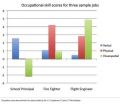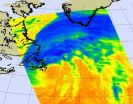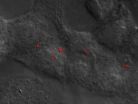(Press-News.org) Toronto, Canada – In an international study of patients with a devastating type of dementia that often strikes in middle age, researchers have found intriguing evidence that career choice may influence where the disease takes root in the brain.
The study was led by Baycrest's Rotman Research Institute in collaboration with the Memory and Aging Centre at the University of California, San Francisco and several U.S. and European clinical sites. It appears online today in the Article in Press section of the journal Neuropsychologia, ahead of publication.
Researchers conducted a multi-centre, retrospective chart review of brain imaging and occupation data from 588 patients diagnosed with frontotemporal lobar degeneration (FTLD), sometimes referred to as frontotemporal dementia (FTD). Among the dementias affecting those 65 years and younger, FTLD is as common as Alzheimer's disease. Like Alzheimer's, it is progressive and fatal. Unlike Alzheimer's, which tends to affect both sides of the brain equally, FTLD often manifests on either the left or the right side of the brain, then becomes more widespread as the disease progresses. Typical symptoms include changes in personality and behaviour, and a decline in language skills.
For this study, each patient's occupation was rated with scores derived from an occupation database published by the U.S. Department of Labor. The scores indicated the skills required for the occupation, including verbal, physical and visuospatial skills. For example, a school principal would receive a higher rating for verbal skills than for visuospatial skills, whereas a flight engineer would show the opposite pattern. Both of these professions would score lower on physical skills than a firefighter.
The researchers correlated each patient's occupation scores with the location of brain tissue loss as determined from brain imaging results. They found that patients with professions rated highly for verbal skills, such as school principals, had greater tissue loss on the right side of the brain, whereas those rated low for verbal skills, such as flight engineers, had greater tissue loss on the left side of the brain. This effect was expressed most clearly in the temporal lobes of the brain.
"The disease appeared to attack the side of the brain that was the least used in the patient's professional life," said Dr. Nathan Spreng, who conducted the study as a psychology graduate student at Baycrest and is now a post doctoral fellow in the Department of Psychology at Harvard University.
The brain's left hemisphere, particularly the temporal lobe, is specialized for language and verbal skills. In occupations ranked highly for verbal skills, tens of thousands of hours of applying these skills may build reserve capacity by strengthening connections in the brain's left hemisphere, making it more resistant to damage due to FTLD, suggested Dr. Spreng. This process may also make the right hemisphere, which is less concerned with verbal tasks, more vulnerable to dementia through disuse.
Yet the researchers could not rule out an alternative explanation. "There may be an undetected functional impairment related to FTLD in these patients that biases them toward a certain career path decades before they get sick," said Dr. Brian Levine of the Rotman Research Institute and senior author on the study.
What is common to both explanations is that the patients' selection and practice of an occupation early in life was related to their brain changes later in life. The authors cautioned that the results were limited to FTLD and may not hold for other brain diseases or conditions.
There is no evidence that someone with a particularly verbal or non-verbal profession is vulnerable to brain disease. However, if that person were to develop FTLD (affecting approximately 250,000 Americans and 25,000 Canadians a year), the location of the disease may relate to occupational practice. Further research will be needed to determine how strong a predictor occupation may be for hemispheric localization of the disease.
INFORMATION:
FTLD patient data for this study was collected from nine neurology clinics in Canada, the U.S., Germany and the U.K. The study was funded by the Canadian Institutes of Health Research and the National Institute of Child Health and Human Development.
For sufferers of an early-onset dementia, career choice may determine location of disease in brain
2010-09-22
ELSE PRESS RELEASES FROM THIS DATE:
Study links normal function of protein, not its build up inside cells, to death of neurons
2010-09-22
A study led by St. Jude Children's Research Hospital investigators links the muscle weakness and other symptoms of a rare neurodegenerative disease to a misstep in functioning of a normal protein, rather than its build-up inside cells. The finding offers insight into the mechanism driving common nervous system disorders like Parkinson's and Alzheimer's diseases.
The work advances understanding of how the inherited mistake at the heart of spinobulbar muscular atrophy (SBMA) leads to the death of neurons in the brain and spinal cord. Investigators showed that the underlying ...
NYC public school students have high levels of access to convenience stores with unhealthy food
2010-09-22
September 22, 2010 -- Most studies of the food choices available near public schools have focused on fast food outlets rather than the full range of options available to schoolchildren. A new study by researchers at Columbia University's Mailman School of Public Health examined the patterns of exposure to a broad range of food outlets for school children in New York City.
The study, "Disparities in the Food Environments of New York City Public Schools," is published in the American Journal of Preventive Medicine Volume 39, Issue 3, and cited as the "Editor's Choice" ...
Chromium picolinate may lessen inflammation in diabetic nephropathy
2010-09-22
Bethesda, Md. (September 22, 2010) – Taking chromium picolinate may help lessen inflammation associated with diabetic nephropathy (kidney disease), say researchers at the Medical College of Georgia in Augusta. In a study comparing diabetic mice treated with chromium picolinate with those that received placebo, the researchers found that mice who received the supplement had lower levels of albuminuria (protein in the urine), an indication of kidney disease.
The Study
To arrive at their conclusions, the researchers compared three groups of mice, one lean, healthy group ...
New species of sea slug discovered by UCSB marine scientist
2010-09-22
(Santa Barbara, Calif.) –– Sometimes, treasures can be found in your own backyard –– especially if you know what to look for. This is what happened to Jeff Goddard, project scientist with the Marine Science Institute at UC Santa Barbara.
Goddard was working in the tide pools at Carpinteria Reef, in Carpinteria State Park, Calif., when he found a new species of nudibranch –– a group of sea slugs noted for their bright colors and delicate forms. Recognizing it as new, Goddard carefully documented the living specimen before preserving it and sending it off to Terrence M. ...
Fruit flies help Yale scientists sniff out new insect repellents
2010-09-22
By following the "nose" of fruit flies, Yale scientists are on the trail of new insect repellents that may reduce the spread of infectious disease and damage to agricultural crops. That's because they've learned for the first time how a group of genes used to differentiate smells is turned on and off, opening new possibilities for insect control. Just as in new drug development, researchers can target these or similar genes in other insects to create substances that make crops and people "invisible" to insect antennae. Without the ability to smell correctly, the insects ...
GOES-13's wide view of Atlantic's Tropical Storm Lisa and low, Pacific's Georgette
2010-09-22
The GOES-13 satellite may be stationed in orbit over the eastern U.S., but it has a wide field of view from the eastern Atlantic to the eastern Pacific, and today it captured three tropical cyclones in one image.
At 1445 UTC (10:45 a.m. EDT) today, Sept. 22, the Geostationary Operational Environmental Satellite called GOES-13 captured Tropical Storm Lisa in the far eastern Atlantic, a developing tropical low in the south-central Caribbean Sea, and Tropical Storm Georgette in the eastern Pacific Ocean, making landfall in Baja California. The GOES series of satellites ...
Huge post-tropical Hurricane Igor drenched Newfoundland, Canada
2010-09-22
Hurricane Igor may have transitioned into a post-tropical hurricane late yesterday, but when he approached Newfoundland, Canada and merged with an area of low pressure it resulted in heavy rainfall throughout the region. NASA satellites captured Igor's northern march toward the Labrador Sea yesterday.
NASA's Terra and Aqua satellites captured visible and infrared images of Hurricane Igor yesterday as he brought heavy rainfall into northeastern Canada. A visible image of Hurricane Igor over Newfoundland, Canada was captured by the Moderate Resolution Imaging Spectroradiometer ...
Human-powered ornithopter becomes first ever to achieve sustained flight
2010-09-22
TORONTO, ON – Aviation history was made when the University of Toronto's human-powered aircraft with flapping wings became the first of its kind to fly continuously.
The "Snowbird" performed its record-breaking flight on August 2 at the Great Lakes Gliding Club in Tottenham, Ont., witnessed by the vice-president (Canada) of the Fédération Aéronautique Internationale (FAI), the world-governing body for air sports and aeronautical world records. The official record claim was filed this month, and the FAI is expected to confirm the ornithopter's world record at its meeting ...
Humanized mice may provide clues to better prevent and treat typhoid fever
2010-09-22
Better treatments and prevention for typhoid fever may emerge from a laboratory model that has just been developed for the disease. The model is based on transplanting human immune stem cells from umbilical cord blood into mice that are susceptible to infections.
The transplanted cells live alongside the mouse's own immune system. Although mice are normally resistant to the dangerous strain of Salmonella that causes typhoid fever, the bacteria are able to reproduce in the mice that have received transplanted human cells.
Because typhoid fever affects only humans, ...
Positive behavioral interventions programs found to improve student behavior and learning
2010-09-22
Los Angeles, CA (September 22, 2010) Adopting the evidence-based procedures of School-Wide Positive Behavioral Interventions and Supports (SWPBIS) helped 21 elementary schools reduce student suspensions, office discipline referrals and improve student academic achievement, according to a study published in the July 2010 issue of the Journal of Positive Behavior Interventions. SWPBIS is a rapidly expanding approach to improving educational environments that is estimated to be used in more than 9,000 schools nation-wide
Researchers at the Johns Hopkins Center for the Prevention ...




